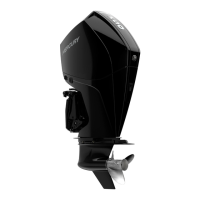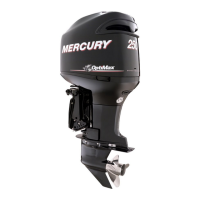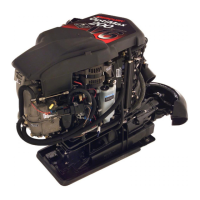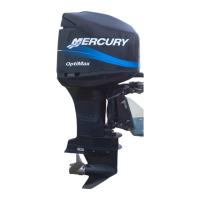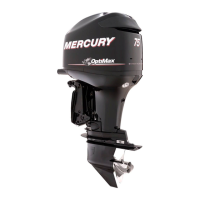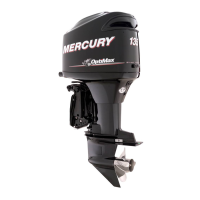DIRECT FUEL INJECTION
Page 3B-19
90-888438 JUNE 2002
To equalize the pulses developed by the pumps (both air and fuel) a tracker diaphragm
is installed in the starboard rail. The tracker diaphragm is positioned between the fuel and
air passages. The tracker diaphragm is a rubber diaphragm which expands and retracts
depending upon which side of the diaphragm senses the pressure increase (pulse).
Oil
Oil in this engine is not mixed with the fuel before entering the combustion chamber. Oil
is stored inside a standard remote oil reservoir. Crankcase pressure will force oil from the
remote oil tank into the oil reservoir on the side of the powerhead. Oil will flow from the
oil reservoir into the oil pump. The oil pump is a solenoid design. It is activated by the ECM
and includes 7 pistons with corresponding discharge ports. The oil pump is mounted di-
rectly onto the powerhead. Each cylinder is lubricated by one of the discharge ports. The
oil is discharged into the crankcase. Bleed hoses carry excess oil from the crankcase to
the transfer ports. The seventh passage connects to the hose that leads to the air com-
pressor for lubrication. Excess oil from the compressor provides lubrication for the upper
and lower crank bearing.
The ECM will change the discharge rate of the oil pump, depending upon engine demand.
The ECM will also pulse the pump on initial start up to fill the oil passages eliminating the
need to bleed the oil system. The ECM provides additional oil for break in, as determined
by its internal clock. The oil ratio varies with engine rpm and load.
Electrical
The electrical system consists of the ECM, crank position sensor (flywheel speed & crank-
shaft position), throttle position sensor (TPS), MAP sensor, engine temperature sensor,
ignition coils and injectors (fuel & direct). The engine requires a battery to start (i.e. the
ignition and injection will not occur if the battery is dead). The system will run off of the
alternator.
Operation
The operation of the system happens in milliseconds (ms); exact timing is critical for en-
gine performance. As the crankshaft rotates, air is drawn into the crankcase through the
throttle shutter, into the plenum and through the reed valves. As the piston nears bottom-
dead-center, air from the crankcase is forced through the transfer system into the cylinder.
As the crankshaft continues to rotate the exhaust and intake ports close. With these ports
closed, fuel can be injected into the cylinder. The ECM will receive a signal from the
throttle position sensor (TPS), engine temperature sensor (TS) and the crank position
sensor (flywheel speed and position sensor). With this information the ECM refers to the
fuel calibration (maps) to determine when to activate (open and close) the injectors and
fire the ignition coils. With the piston in the correct position, the ECM opens the fuel injec-
tor, 90 psi fuel is discharged into a machined cavity inside the air chamber of the air/fuel
rail. This mixes the fuel with the air charge. Next the direct injector will open, discharging
the air/fuel mixture into the combustion chamber. The direct injector directs the mixture
at the bowl located in top of the piston. The piston’s bowl directs the air/fuel mixture into
the center of the combustion chamber. This air fuel mixture is then ignited by the spark
plug.
Compressor Notes: To aid in starting when the air rail pressure is low and before the
compressor has time to build pressure, some direct injectors are held open by the ECM.
This allows the compression from inside the cylinders to pressurize the air rail faster (1
or 2 strokes, or 60
°
of crankshaft rotation).
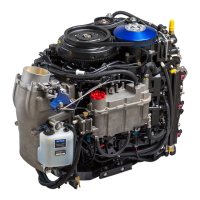
